Path Load Adaptive Migration for Routing and Bandwidth Allocation in Mobile-Aware Service Function Chain
Abstract
:1. Introduction
- We consider the user estimable movement scenario with known mobile paths and estimable arrival time. There is no research on migration in this scenario.
- Utilizing the estimable movement characteristics, we propose a softer migration strategy migrating before the user reaches the corresponding access node to reduce the user waiting time.
- We propose the PLARBA algorithm adjusting the migration bandwidth according to the path load to reduce the migration failure rate.
2. Related Work
2.1. Service Continuity for Mobile User
2.2. Live Migration
3. System Model
3.1. Problem Statement
- Physical network: We assume that each node has the same attributes, and each link has the same bandwidth [10].
- Mobile user: According to the central limit theorem [29], we assume that the user arrival time to the destination node follows the normal distribution. We also assume that users entering the network follow a Poisson distribution [12]. In most cases, users only request one service; thus, we assume that one SFC provides services for one user.
- Mobile-aware SFC: Because the migration time is affected by the memory of VNFs, we assume that the memory of VNFs obeys a uniform distribution [13,14]. To simplify, we assume that each migrated VNF of the same SFC starts to migrate at the same time. Although sharing a VNF instance (VNFI) among SFCs can save resources and reduce the number of migrations, the limited location of VNFIs can lead to the SFC having a larger delay and occupying more links. The authors of [10,12] did not consider sharing VNFI; thus, we assume that VNFI cannot be shared by more than one SFC.
3.2. Physical Network Model
3.3. User Estimable Movement Scenario
- The user’s movement path is known;
- The user’s arrival time is regular and estimable.
3.4. SFC Migration Request Model
3.5. Problem Formulation
- (1)
- Objective function: The first objective is to reduce the user waiting time for the migration completion. To simply, when the user’s access node is changed, the extended link is not considered to provide service. If the corresponding SFC is not migrated to the changed node, the service will be interrupted; hence, the user waiting time for migration completion is also the service downtime. Then, the second objective function is the failure rate of SFC migration. Reducing the migration failure rate can effectively maintain service stability and improve users’ QoS in the user estimable movement scenario.where , , and are the user waiting time, the migration completion time of si, and the actual time when the corresponding user ui reaches the target node, respectively. F is the failure rate of SFC migrations, Fn is the migration failure number, and |SF| is the number of SFCs. In one migration, si migration involves multiple VNF migrations. is subject to the maximum completion time of VNF migration in Equation (5),where is the completion time of VNF migration. Each migration needs to satisfy the constraints below.
- (2)
- Constraints: Different deployment locations of the original chain and the prepared chain trigger the mobile-aware SFC migration. In Figure 1, the original SFC’s VNFs are deployed in n1, n2, n3, and n4, the prepared SFC’s VNFs are deployed in n5, n2, n3, and n4, and VNF1 is migrated from n1 to n5. Although this paper focuses on migration strategy, the original and prepared chains of the SFC still need to be deployed in the algorithm. Thus, we need to consider the constraints of deployment and migration.
4. Approach to the Problem
4.1. Softer Migration
4.2. Path Load Adaptive Routing and Bandwidth Allocation (PLARBA) Algorithm
| Algorithm 1. Migration algorithm of overall process |
| Input: Physical network , the set of SFCs , the set of users , each SFC , each user’s movement path and arrival time distribution , confidence level , memory dirtying rate . |
| Output: Number of SFCs failed to migrate , failed SFC set , network migration record . |
| 1 , , . |
| 2 for each user do |
| 3 for each movement do |
| 4 According to Q and C, obtain estimated time section |
| 5 The last migration completion triggers the migration decision of SFC in this movement. |
| 6 Call Algorithm 2 to obtain , source and destination nodes. |
| 7 for each migrated VNF do |
| 8 Obtain migration request . |
| 9 Execute Algorithm 3 to obtain , , . |
| 10 if then |
| 11 . |
| 12 Add to FSFC. |
| 13 Delete the original chain and the prepared chain. |
| 14 break. |
| 15 else |
| 16 Add , , to . |
| 17 Perform migration immediately. |
| 18 if migration meets downtime condition in Equation (13) then |
| 19 if not receive then |
| 20 Continue the migration to wait for the user. |
| 21 Actual migration time . |
| 22 else |
| 23 Actual migration time . |
| 24 Add to . |
| 25 Using Equations (3) and (5), calculate user waiting time in this movement, and add to . |
| 26 Release the original chain and start the prepared chain. |
| 27 return , , . |
- (1)
- Establish user estimable movement scenario to obtain the estimated time section of arrival time: After the user starts moving to the corresponding access node, on the basis of the normal distribution of user arrival time and confidence level, we obtain the estimated time section of actual arrival time .
- (2)
- Obtain migrated VNFs, source nodes, and destination nodes: When the user starts to move, on the basis of the known access node, we deploy the prepared chain on the shortest path between the next access node and the output node. According to the original and prepared chain’s VNF deployment location, we obtain the migrated VNFs in this movement, the corresponding migration source nodes, and destination nodes in Algorithm 2. If the shortest link does not meet the deployment constraints in Equations (6)–(10), we regard it as a migration failure caused by deployment.
| Algorithm 2. Deploying prepared chain |
| Input: corresponding SFC , |
| Output: , , , source and destination nodes. |
| 1 According to , obtain the next access node of . |
| 2 Deploy the prepared chain on the shortest path between the next access node and the output node. |
| 3 if constraints in Equations (6)–(10) are not satisfied then |
| 4 . |
| 5 Add to FSFC. |
| 6 Delete the original chain. |
| 7 break; |
| 8 According to the original chain and prepared chain, determine which VNFs to migrate , source nodes, and destination nodes. |
| 9 return , , , source and destination nodes. |
- (3)
- Implement PLARBA algorithm: We acquire the migration requests including the memory dirtying rate, memory size, and user information, and then input them into PLARBA algorithm. The PLARBA in Algorithm 3 mainly has two parts.
Algorithm 3. PLARBA Input: Migration request . Output: Decision migration path , decision migration bandwidth , and decision migration time . 1 Candidate migration path set . 2 Find path set between source node and destination node . 3 for each path do 4 If bandwidth meets constraints in Equations (11), (13), and (16) then 5 Add to . 6 for each path do 7 Record ’s length. 8 The path with the least length in H is the decision migration path . 9 Using Equations (17) and (18), obtain path load and decision migration bandwidth . 10 Using Equation (14), obtain decision migration time . 11 return , , . - Routing selection: We find all the paths between the source node and the destination node of migration according to the deployment of the original chain and the prepared chain. Then, we traverse the path set. Each path meeting the constraints of migration bandwidth, migration time, and downtime in Equations (11), (13), and (16) is added to the candidate path set. After that, the migration path with the least length in the candidate path set is the decision migration path. If no migration path meets the constraints, the migration fails.
- Bandwidth Allocation: When the path has more remaining bandwidth, more bandwidth should be allocated to make better use of resources and complete faster. Conversely, less migration bandwidth is allocated, which makes it possible to provide bandwidth for other migration tasks as they pass through the same paths, to avoid network congestion and migration failure. The authors of [15] only took the migration path length as the standard to measure the path load, where a shorter path length indicates that the allocated bandwidth is closer to the maximum bandwidth. In this paper, we propose the following indicators for measuring the path load: (i) the path length, and (ii) the bandwidth occupancy rate of each path segment. We use the normalization method to measure the path load using Equation (17),where represents the migration path length of VNF migration task, and are the shortest and longest length in the path set, respectively. is the bandwidth occupation rate of each path segment in the migration path, i.e., the ratio of occupied bandwidth to total bandwidth, the minimum sum of is 0, and the maximum is .
- (4)
- Adopt path and bandwidth, perform the migration: We execute all VNF migration tasks for the SFC. If the migration has met the stop-and-copy constraint in Equation (13) before the user arrives, the migration continues to wait for the user, and the actual migration completion time Te(vy)′ is the sum of the user’s actual arrival time and resumption time of pre-copy; otherwise, it is the decision migration completion time in Equation (14). After the user reaches the destination node and all VNF migrations are completed, we release the original chain and start the prepared chain.
5. Simulation Results
5.1. Simulation Setting
5.2. Softer Migration and Soft Migration with One SFC
- (1)
- The influence of confidence level: Figure 7a depicts that, compared with SM, the user waiting time of SEM was significantly reduced by 94.3% for , 95.4% for , 96.5% for , and 97.7% for . As confidence increased, the user waiting time of the two strategies gradually decreased. For the SEM algorithm, the waiting time for was 69.6% less than that for . For the SM algorithm, the indicator for was 25.7% less than that for . This is because, as accuracy increased, and the decision migration time decreased. However, the migration could not enter the stop-and-copy stage until the user arrived, and the actual migration time approached the user arrival time. Thus, the user waiting time approached gradually.
- (2)
- The influence of standard deviation: In Figure 7b, compared with SM, SEM reduced the user waiting time by 97.9% for , 98.0% for , 98.3% for , and 97.7% for . With standard deviation increasing, the indicators of the two strategies showed a falling trend. For the SEM algorithm, the waiting time for was 22.6% less than that for . For the SM algorithm, the waiting time at was 30.9% less than that for . Similarly, with standard deviation increasing, also reduced, leading to the user waiting time approaching .
5.3. PLARBA Algorithm and Two Comparison Algorithms with Multiple SFCs
- Average migration bandwidth: The average migration bandwidth allocated for all requests.
- Network load maximum: The maximum sum of occupied bandwidth in physical links from when the first user enters the network to when no users are in the network.
- The number of SFC migrations: The total migration times of the SFCs without migration failure and the existing migration times of the SFCs with midway migration failure.
- The number of VNF migrations: The total number of VNF migrations from when the first user enters the network to when there are no users.
- Failure rate of SFC migration: Ratio of the number of SFCs with migration failure to the number of SFCs.
- (1)
- Average migration bandwidth: As shown in Figure 8a, the average migration bandwidth of PLARBA was significantly lower than that of the two comparison algorithms because it considered the path length and the path bandwidth occupancy. In addition, when the number of SFCs changed, the differences in migration bandwidth were within the range [1.5, 2.6] MB/T. When there were 80 SFCs, the bandwidth of PLARBA decreased by 2.6 MB/T compared with that of DARBA. As more and more SFCs were introduced into the network, the migration bandwidth tended to decrease. Compared with the case of 20 SFCs, the indicator of 90 SFCs was reduced by 3.5% using PLARBA, 1.3% using DARBA, and 0.3% using MAXRBA. When the number of SFCs increased, the maximum bandwidth satisfying the constraints decreased and the adaptive coefficient of PLARBA was larger, leading to less allocated bandwidth.
- (2)
- Network load maximum: As shown in Figure 8b, when there were 20 SFCs in the network, the indicator of PLARBA was 362.8 MB/T less than that of DARBA and 426.9 MB/T less than that of MAXRBA. When more users were set in the network, the load value of PLARBA was higher than that of the two comparison algorithms because PLARBA could migrate more SFCs successfully through load adaption. When 90 SFCs were considered, the indicator of PLARBA increased by 156.8 MB/T compared to DARBA and 472.7 MB/T compared to MAXRBA. The network load values of the three algorithms increased with the number of users. For PLARBA, the load value with 90 SFCs was 135.1% higher than that with 20 SFCs compared to 103.6% for DARBA and 90.0% for MAXRBA. Regardless of the algorithm, the increasing trend gradually slowed down due to the limited capacity of the network.
- (3)
- The number of SFC migrations: Figure 9a displays that PLARBA had more SFC migrations compared with the two other algorithms. When 50 SFCs were set, the value of the PLARBA algorithm increased by 25.2% and 20.7% compared with DARBA and MAXRBA, respectively. When 70 SFCs were set, the value of the PLARBA algorithm increased by 24.8% and 24% compared with DARBA and MAXRBA, respectively. When the number of SFCs increased from 20 to 90, the differences in migration times among the three algorithms increased gradually. When the network had more than 50 SFCs, the differences remained stable. More users in the network led to more SFC migrations. Similarly, the number of SFC migrations increased to the saturation point.
- (4)
- The number of VNF migrations: As shown in Figure 9b, the number of VNF migrations when adopting the PLARBA algorithm was 2–3 times that of the corresponding SFC migrations because each SFC migration caused two or three VNF migrations. When considering 50 SFCs, the value of the PLARBA algorithm increased by 18.9% and 17.1% compared with DARBA and MAXRBA, respectively. When considering 70 SFCs, the value of the PLARBA algorithm increased by 16.5% and 22.7% compared with DARBA and MAXRBA, respectively. As the number of SFCs increased from 20 to 50, the difference in this indicator among the three algorithms gradually increased. When considering more than 50 SFCs, the difference mainly remained in a specific range. Similar to the number of SFC migrations, compared with 20 SFCs, the number of VNF migrations for the PLARBA algorithm with 90 SFCs increased by 140.8%, the indicator for DARBA increased by 100%, and the indicator for MAXRBA increased by 123.8%.
- (5)
- Failure rate of SFC migration: Figure 10 shows that the migration failure rate of PLARBA was always higher than that of the two comparison algorithms, indicating that considering the path length and bandwidth occupancy can significantly reduce the indicator. When considering 50 SFCs in the network, compared with DARBA, the failure rate of PLARBA decreased by 75.4%, and the decline was the most obvious. Comparing PLARBA and DARBA, the failure rate of PLARBA with 70 SFCs decreased by 42.9%, while the failure rate of PLARBA with 90 SFCs decreased by 22.4%. When the number of SFCs increased, the difference among the three algorithms first increased and then decreased. More SFCs were set when fewer users were in the network, more SFCs were migrated successfully, and the advantage of load adaptation was more pronounced. However, when the number of users was large, the remaining bandwidth of the physical link was less, and the load adaption ability of PLARBA was limited.
6. Conclusions
Author Contributions
Funding
Acknowledgments
Conflicts of Interest
References
- Mouradian, C.; Kianpisheh, S.; Abu-Lebdeh, M. Application Component Placement in NFV-Based Hybrid Cloud/Fog Systems with Mobile Fog Nodes. IEEE J. Sel. Areas Commun. 2019, 37, 1130–1143. [Google Scholar] [CrossRef]
- Wang, Z.; Sun, D.; Xue, G.; Qian, S.; Li, G.; Li, M. Ada-Things: An adaptive virtual machine monitoring and migration strategy for internet of things applications. J. Parallel Distrib. Comput. 2018, 132, 164–176. [Google Scholar] [CrossRef]
- Herrera, J.G.; Botero, J.F. Resource Allocation in NFV: A Comprehensive Survey. IEEE Trans. Netw. Serv. Manag. 2017, 13, 518–532. [Google Scholar] [CrossRef]
- Yang, S.; Li, F.; Trajanovski, S.; Yahyapour, R.; Fu, X. Recent Advances of Resource Allocation in Network Function Virtualization. IEEE Trans. Parallel Distrib. Syst. 2021, 32, 295–314. [Google Scholar] [CrossRef]
- Qin, J.; Wu, Y.; Chen, Y.; Xue, K.; Wei, D.S.L. Online User Distribution-aware Virtual Machine Re-Deployment and Live Migration in SDN-based Data Centers. IEEE Access 2019, 7, 11152–11164. [Google Scholar] [CrossRef]
- Tang, L.; He, X.; Zhao, P.; Zhao, G.; Zhou, Y.; Chen, Q. Virtual Network Function Migration Based on Dynamic Resource Requirements Prediction. IEEE Access 2019, 7, 112348–112362. [Google Scholar] [CrossRef]
- Shen, H.; Chen, L. A Resource Usage Intensity Aware Load Balancing Method for Virtual Machine Migration in Cloud Datacenters. IEEE Trans. Cloud Comput. 2020, 8, 17–31. [Google Scholar] [CrossRef]
- Paulraj, G.J.L.; Francis, S.A.J.; Peter, J.D.; Jebadurai, I.J. Route Aware Virtual Machine Migration in Cloud Datacenter. In Proceedings of the 2018 Second International Conference on Inventive Communication and Computational Technologies (ICICCT), Coimbatore, India, 20–21 April 2018; pp. 363–367. [Google Scholar] [CrossRef]
- Shoura, F.; Gharaibeh, A.; Alouneh, S. Optimization of Migration Cost for Network Function Virtualization Replacement. In Proceedings of the 2020 21st International Arab Conference on Information Technology (ACIT), Giza, Egypt, 28–30 November 2020; pp. 1–7. [Google Scholar] [CrossRef]
- Chen, Y.T.; Liao, W. Mobility-Aware Service Function Chaining in 5G Wireless Networks with Mobile Edge Computing. In Proceedings of the ICC 2019–2019 IEEE International Conference on Communications (ICC), Shanghai, China, 20–24 May 2019; pp. 1–6. [Google Scholar] [CrossRef]
- Taleb, T.; Ksentini, A.; Frangoudis, P. Follow-Me Cloud: When Cloud Services Follow Mobile Users. IEEE Trans. Cloud Comput. 2016, 7, 369–382. [Google Scholar] [CrossRef]
- Zhao, D.; Sun, G.; Liao, D.; Xu, S.; Chang, V. Mobile-aware service function chain migration in cloud-fog computing. Future Gener. Comput. Syst. 2019, 96, 591–604. [Google Scholar] [CrossRef]
- Xia, J.; Pang, D.; Cai, Z.; Xu, M.; Hu, G. Reasonably Migrating Virtual Machine in NFV-Featured Networks. In Proceedings of the 2016 IEEE International Conference on Computer and Information Technology (CIT), Nadi, Fiji, 8–10 December 2016; pp. 361–366. [Google Scholar] [CrossRef]
- Yang, L.; Yang, D.; Cao, J.; Sahni, Y.; Xu, X. QoS Guaranteed Resource Allocation for Live Virtual Machine Migration in Edge Clouds. IEEE Access 2020, 8, 78441–78451. [Google Scholar] [CrossRef]
- Ayoub, O.; Musumeci, F.; Tornatore, M.; Pattavina, A. Efficient Routing and Bandwidth Assignment for Inter-Data-Center Live Virtual-Machine Migrations. IEEE/OSA J. Opt. Commun. Netw. 2017, 9, B12–B21. [Google Scholar] [CrossRef]
- Achar, A.; Bharathi, D.; Kumar, B.A.; Vanajakshi, L. Bus Arrival Time Prediction: A Spatial Kalman Filter Approach. IEEE Trans. Intell. Transp. Syst. 2020, 21, 1298–1307. [Google Scholar] [CrossRef]
- Hua, X.D.; Yang, J.Q.; Wang, W. Hybrid Bus Arrival Time Prediction Models Based on Data Fusion. J. Highw. Transp. Res. Dev. 2019, 36, 112–120. [Google Scholar]
- Guan, Y.; Zong, Y.; Liu, Y. Virtual Network Embedding Supporting User Mobility in 5G Metro/Access Networks. In Proceedings of the ICC 2019 IEEE International Conference on Communications (ICC), Shanghai, China, 20–24 May 2019; pp. 1–7. [Google Scholar] [CrossRef]
- Nasrin, W.; Xie, J. SharedMEC: Sharing Clouds to Support User Mobility in Mobile Edge Computing. In Proceedings of the 2018 IEEE International Conference on Communications (ICC 2018), Kansas City, MO, USA, 20–24 May 2018; pp. 1–6. [Google Scholar] [CrossRef]
- Liu, L.; Liu, X.; Zeng, S. Research on virtual machines migration strategy based on mobile user mobility in mobile edge computing. J. Chongqing Univ. Posts Telecommun. (Nat. Sci. Ed.) 2019, 18, 570–584. [Google Scholar]
- Ding, Y.; Liu, C.; Li, K. Task Offloading and Service Migration Strategies for User Equipments with Mobility Consideration in Mobile Edge Computing. In Proceedings of the 2019 IEEE Intl. Conf. on Parallel & Distributed Processing with Applications, Big Data & Cloud Computing, Sustainable Computing & Communications, Social Computing & Networking, Xiamen, China, 16–18 December 2019; pp. 176–183. [Google Scholar]
- Islam, M.; Razzaque, A.; Islam, J. A genetic algorithm for virtual machine migration in heterogeneous mobile cloud computing. In Proceedings of the 2016 International Conference on Networking Systems and Security (NSysS), Dhaka, Bangladesh, 7–9 January 2016; pp. 1–6. [Google Scholar]
- Damania, K.; Holmukhe, S.; Singhai, V. An Overview of VM Live Migration Strategies and Technologies. In Proceedings of the 2018 Second International Conference on Electronics, Communication and Aerospace Technology (ICECA), Coimbatore, India, 29–31 March 2018; pp. 1185–1190. [Google Scholar]
- Mandal, U.; Chowdhury, P.; Tornatore, M.; Martel, C.U.; Mukherjee, B. Bandwidth Provisioning for Virtual Machine Migration in Cloud: Strategy and Application. IEEE Trans. Cloud Comput. 2016, 6, 967–976. [Google Scholar] [CrossRef]
- Li, Z.; Wu, G. Optimizing VM live migration strategy based on migration time cost modeling. In Proceedings of the 2016 ACM/IEEE Symposium on Architectures for Networking and Communications Systems (ANCS), Santa Clara, CA, USA, 17–18 March 2016; pp. 99–109. [Google Scholar]
- Tziritas, N.; Loukopoulos, T.; Khan, S.U. Online Live VM Migration Algorithms to Minimize Total Migration Time and Downtime. In Proceedings of the 2019 IEEE International Parallel and Distributed Processing Symposium (IPDPS), Rio de Janeiro, Brazil, 20–24 May 2019; pp. 99–109. [Google Scholar]
- Addya, S.K.; Turuk, A.K.; Satpathy, A.; Sahoo, B.; Sarkar, M. A Strategy for Live Migration of Virtual Machines in a Cloud Federation. IEEE Syst. J. 2018, 13, 2877–2887. [Google Scholar] [CrossRef]
- Kherbache, V.; Madelaine, E.; Hermenier, F. Scheduling Live Migration of Virtual Machines. IEEE Trans. Cloud Comput. 2017, 8, 282–296. [Google Scholar] [CrossRef]
- Gao, M.; Li, Y.; Dobre, O.A.; Al-Dhahir, N. Blind Identification of SFBC-OFDM Signals Based on the Central Limit Theorem. IEEE Trans. Wirel. Commun. 2019, 18, 3500–3514. [Google Scholar] [CrossRef]
- SFCSim Simulation Platform. Available online: https://github.com/SFCSim/SFCSim (accessed on 5 January 2021).
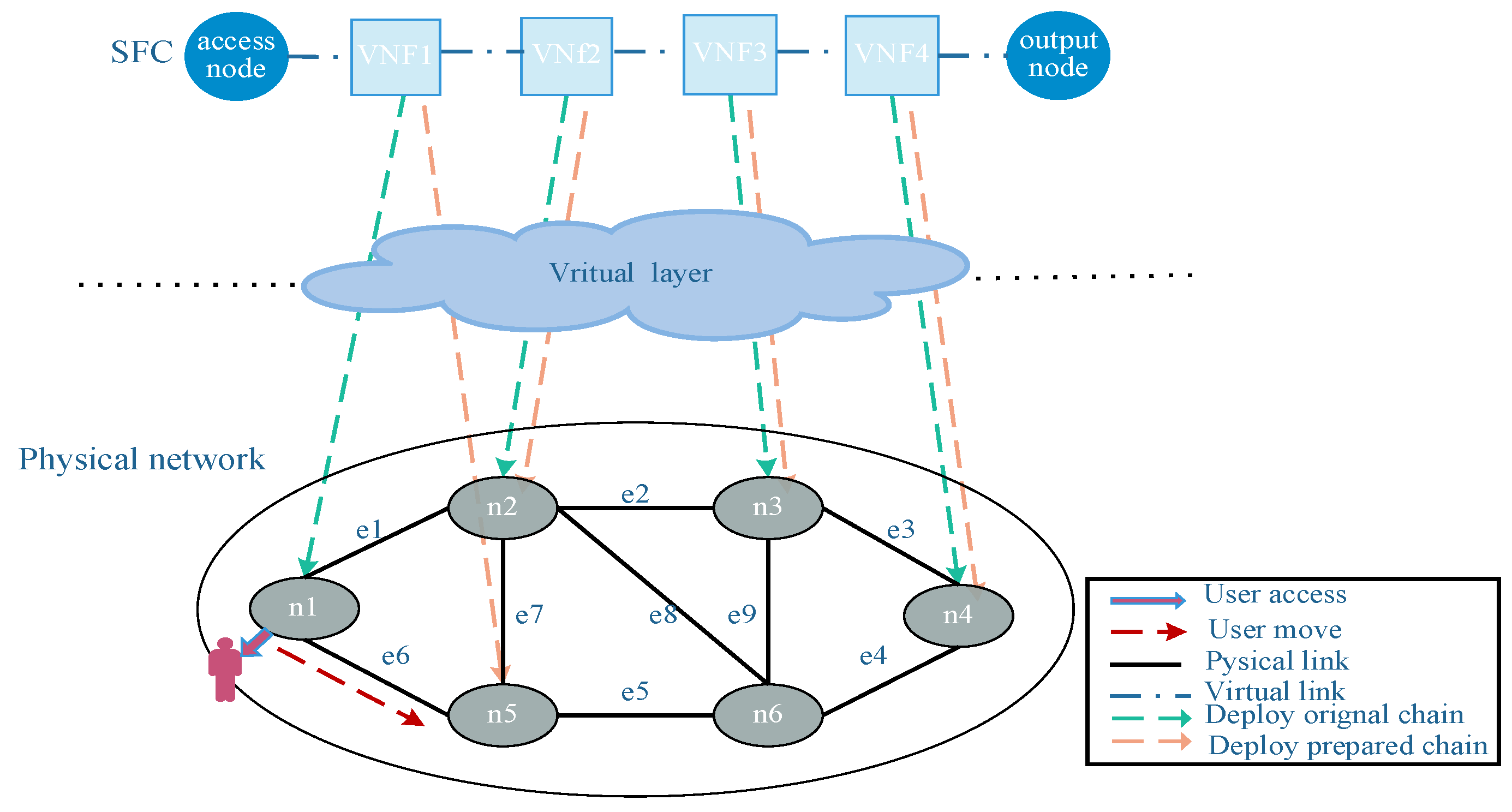
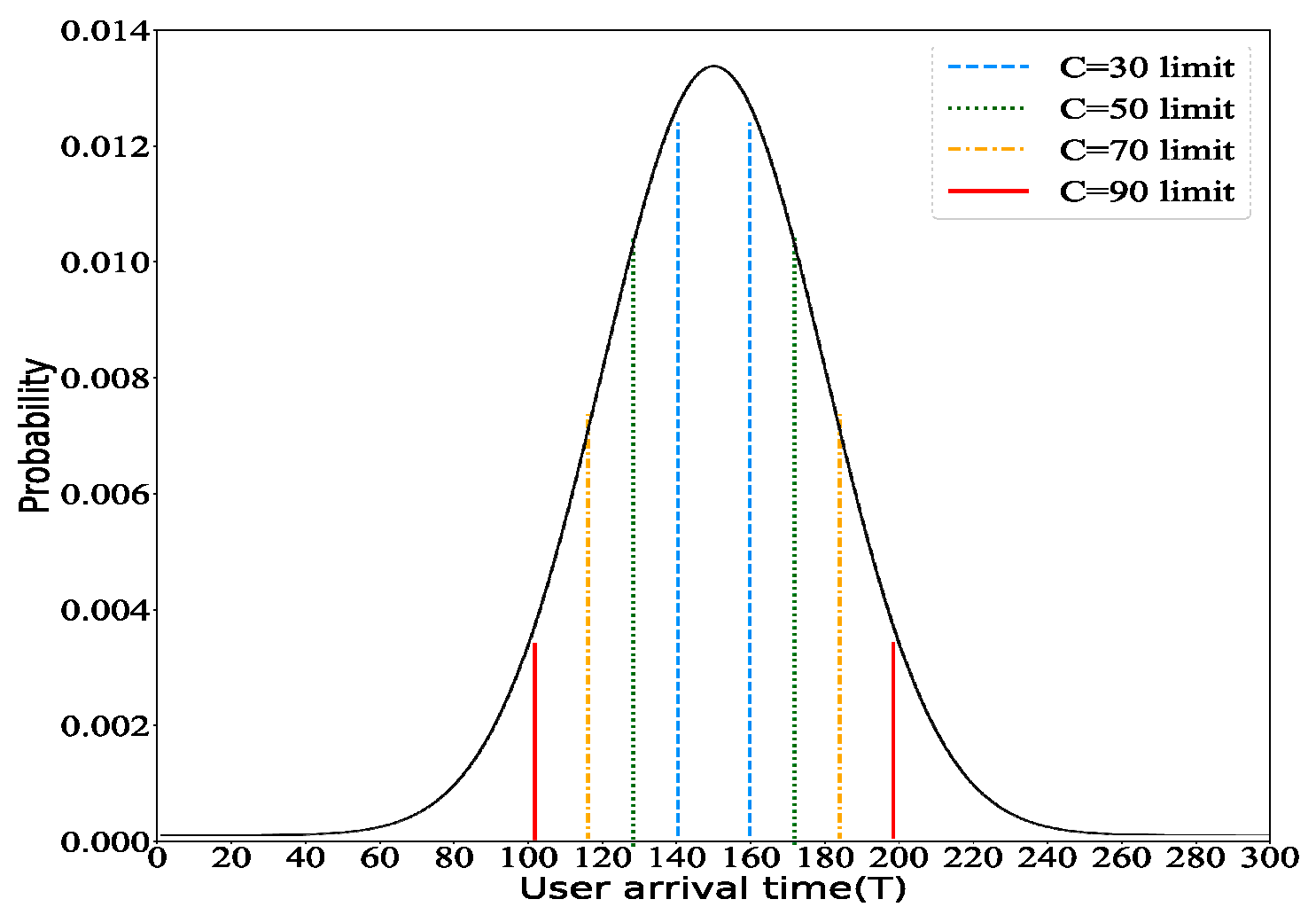

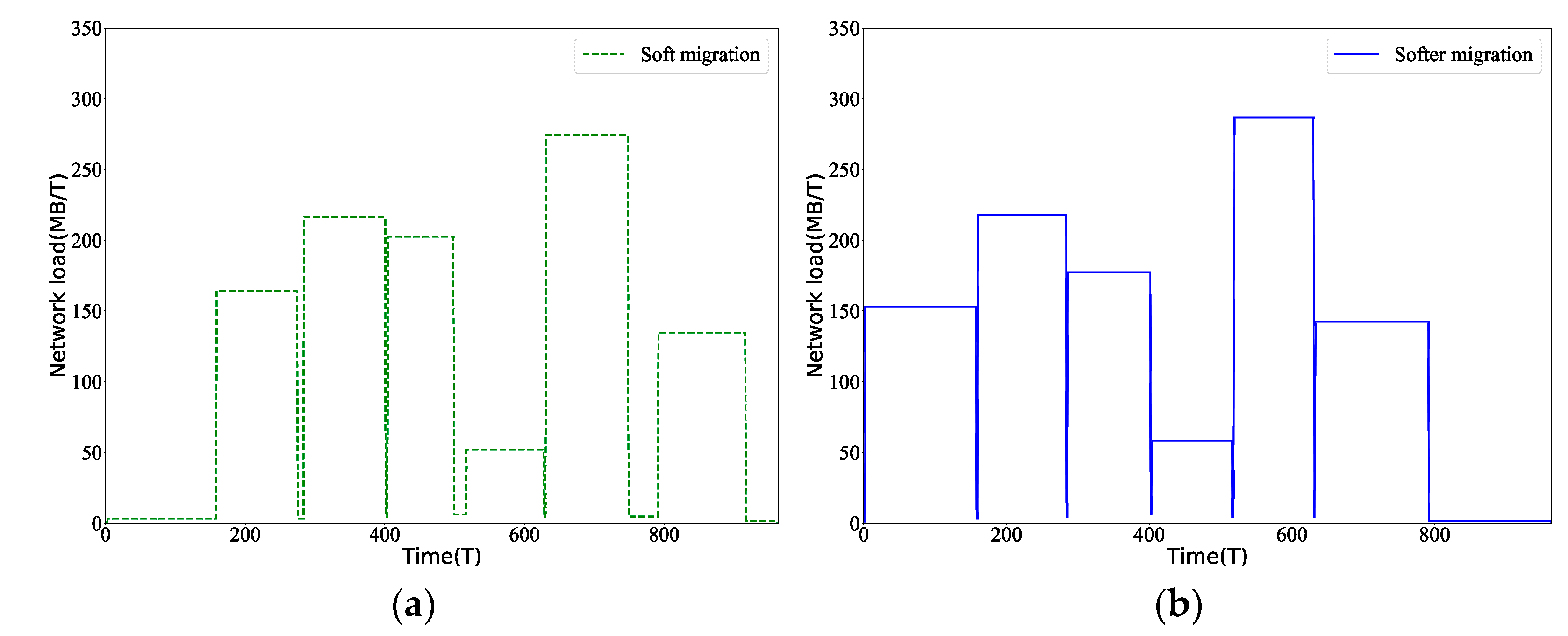


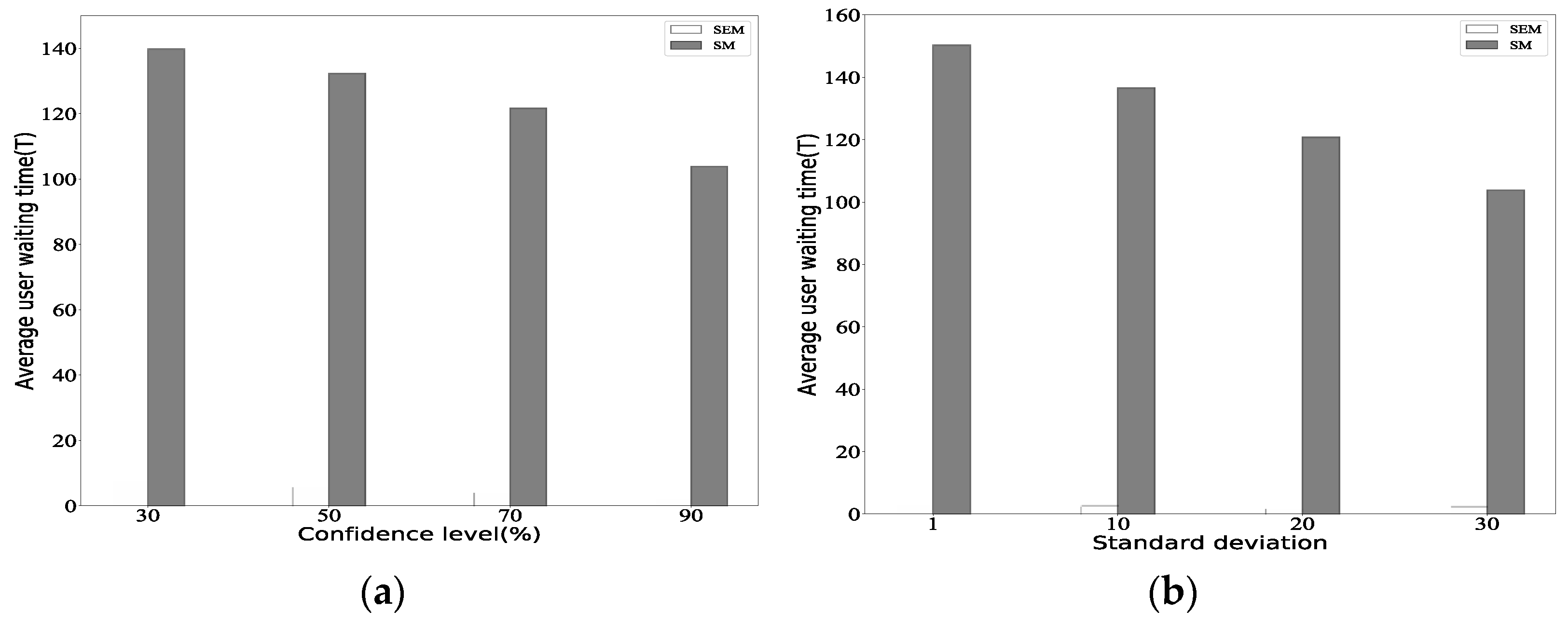


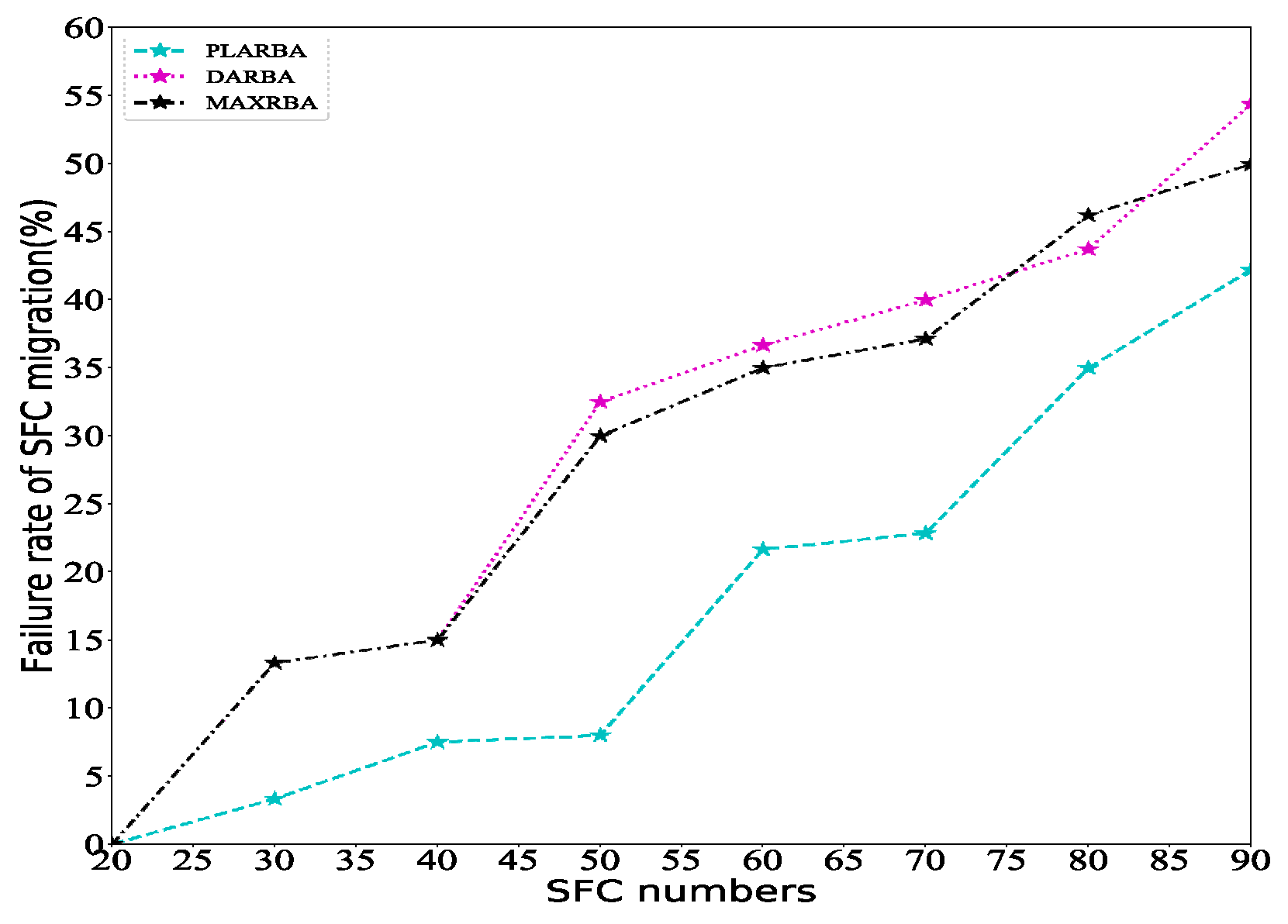
| Function | Notation | Definition |
|---|---|---|
| Parameter | Physical network, composed of the set of physical nodes and the set of physical links. | |
| The set of SFCs, where is the number of SFCs. | ||
| One mobile-aware SFC , composed of the set of VNFs, the set of links, and the set of access nodes. | ||
| The set of migrated VNFs for , where is the number of migrated VNFs. | ||
| VNF migration request. | ||
| The set of users, where is the number of users. | ||
| Mean of the user arrival time, actual arrival time, and standard deviation. | ||
| . | CPU, storage, and memory resources of . | |
| Remaining CPU, storage, and memory resources of physical node . | ||
| Deployed bandwidth of , remaining bandwidth of physical link , delay of the physical link , and maximum delay. | ||
| Maximum bandwidth, resume time, and downtime threshold. | ||
| Decision variable | Estimated time section. | |
| Downtime, the migration completion time of , and actual arrival time of corresponding . | ||
| Migration failure rate and migration failure number. | ||
| Binary variables. | ||
| Migration path set, candidate migration path set, and shortest and longest length in . | ||
| Migration path and its length. | ||
| Minimum and maximum migration bandwidth meeting the constraints. | ||
| Migration path load and migration bandwidth. | ||
| Decision migration time, decision completion time, and actual completion time. |
Publisher’s Note: MDPI stays neutral with regard to jurisdictional claims in published maps and institutional affiliations. |
© 2021 by the authors. Licensee MDPI, Basel, Switzerland. This article is an open access article distributed under the terms and conditions of the Creative Commons Attribution (CC BY) license (https://creativecommons.org/licenses/by/4.0/).
Share and Cite
Hu, H.; Yang, C.; Xu, L.; Song, T.; Dalia, B.B. Path Load Adaptive Migration for Routing and Bandwidth Allocation in Mobile-Aware Service Function Chain. Electronics 2022, 11, 57. https://doi.org/10.3390/electronics11010057
Hu H, Yang C, Xu L, Song T, Dalia BB. Path Load Adaptive Migration for Routing and Bandwidth Allocation in Mobile-Aware Service Function Chain. Electronics. 2022; 11(1):57. https://doi.org/10.3390/electronics11010057
Chicago/Turabian StyleHu, Hefei, Chen Yang, Lingyi Xu, Tangyijia Song, and Bonaho Bocochi Dalia. 2022. "Path Load Adaptive Migration for Routing and Bandwidth Allocation in Mobile-Aware Service Function Chain" Electronics 11, no. 1: 57. https://doi.org/10.3390/electronics11010057
APA StyleHu, H., Yang, C., Xu, L., Song, T., & Dalia, B. B. (2022). Path Load Adaptive Migration for Routing and Bandwidth Allocation in Mobile-Aware Service Function Chain. Electronics, 11(1), 57. https://doi.org/10.3390/electronics11010057







